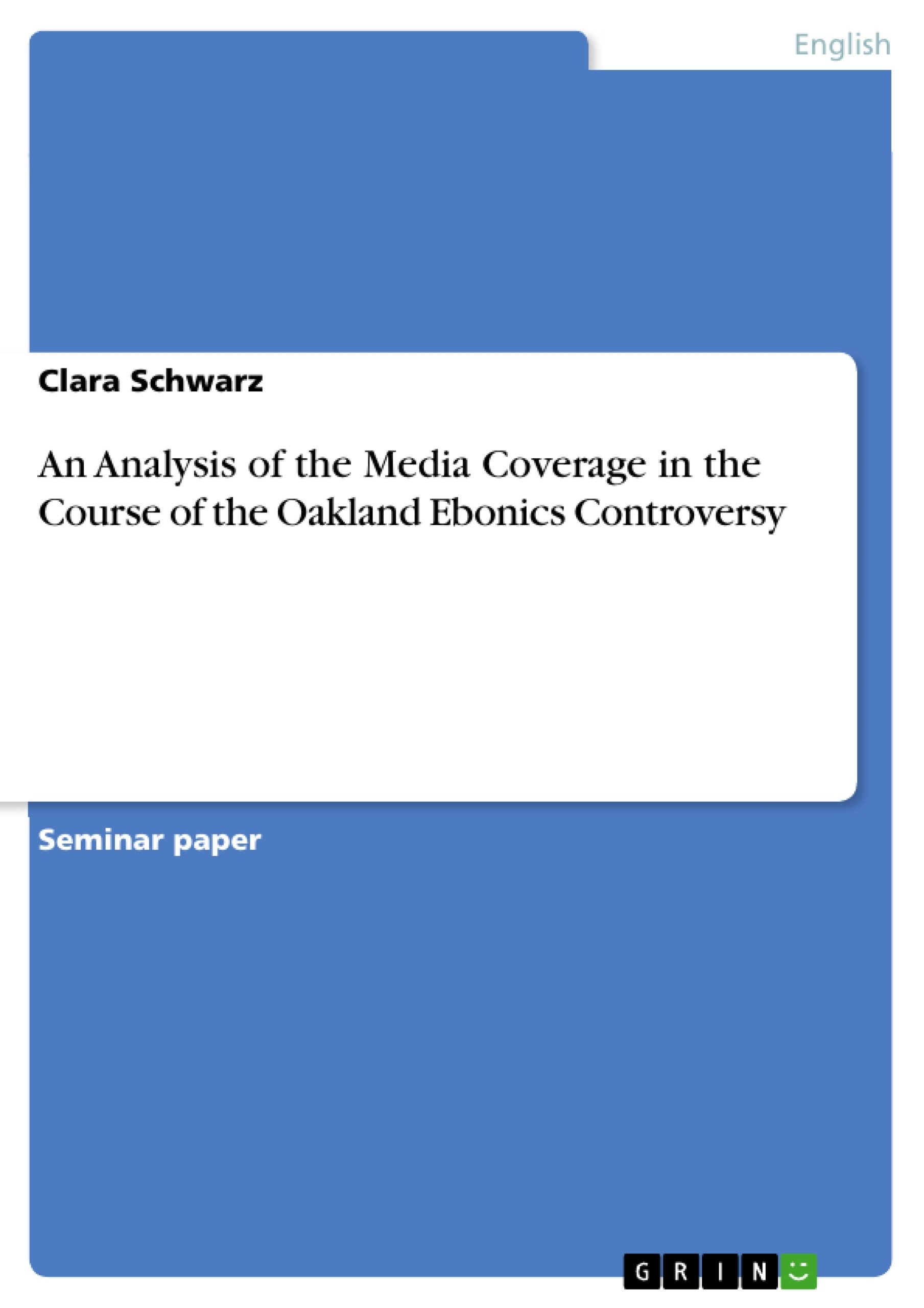The United States is characterized by extensive linguistic diversity. One variation of American English has always been at the centre of scholarly research and publications – African American Vernacular English (AAVE). In 1990, the African Americans made up 12 percent of the total population, which corresponds to 39.930.524 people of whom it is estimated that 80–90 percent speak AAVE. Because of its distinctiveness and its omnipresence in music and culture, AAVE has always been of great interest to sociolinguistic scholars. Especially since the “Oakland Ebonics Controversy” in 1996, lively debates about AAVE and the educational crisis facing African American students can be found in public discourses and in the media.
The Oakland School District’s proposal to use Ebonics to help African-American children learn Standard English met with much opposition. Few people supported the Oakland resolution which, backed by the LSA, acknowledged Ebonics as a language variety replete with its own syntax, structure, and grammatical rules. Although the issue of language and educational equity for African American students has been discussed many times before, basic opinions and prejudices of the US American society have not changed.
In the following text, this issue will be examined from two different perspectives. First, an analysis of opinion articles published in two major newspapers will present and argue basic core elements of the media’s critique. Thereafter, the linguists’ response concerning the media debate will be portrayed. Many linguists discussed the subject and critically assessed the way the media dealt with the hotly debated topic and the way it was represented. The crucial question is; why was there such a public outcry, despite the fact that the fundamental issues attending language diversity and education in Oakland differed little from those that language professionals have dealt with for several decades? And secondly, what can be learned from this.
Inhaltsverzeichnis (Table of Contents)
- INTRODUCTION
- 1. WHAT IS EBONICS/AFRICAN AMERICAN VERNACULAR ENGLISH
- 1.1 ORIGIN AND BACKGROUND
- 1.2 EBONICS/AAVE CHARACTERISTICS
- 2. THE EBONICS CONTROVERSY
- 2.1 THE OAKLAND CASE
- 2.2 EXCURSUS: THE BLACK ENGLISH TRIAL AT THE ANN ARBOR SCHOOL
- 3. MEDIA RESPONSE
- 3.1 RESEARCH DESIGN
- 3.2 MAIN POINTS OF CONTROVERSY
- ISSUE #1: Is Ebonics a DISTINCT LANGUAGE OR MERELY SLANG? IS EBONICS INCORRECT ENGLISH?
- ISSUE #2: BASIC MISUNDERSTANDING: STUDENTS WILL BE TAUGHT IN EBONICS/AAVE.
- ISSUE #3: DOES RECOGNIZING MINORITY SPEECH PATTERNS IMPROVE STUDENTS' PERFORMANCE OR IS THERE A PROBLEM WITH THE EDUCATIONAL SYSTEM IN GENERAL?
- ISSUE #4: FUNDING FOR LIMITED ENGLISH PROFICIENCY STUDENTS OR EBONICS SPEAKERS
- 3.3 OVERALL IMPRESSION
- 4. LINGUISTS' RESPONSE TO MEDIA CRITICISM
- 4.1 RACISM IN THE NEWS
- 4.2 LESSONS LEARNED FROM OAKLAND
- 4.3 NEED FOR EDUCATION
- CONCLUSION
Zielsetzung und Themenschwerpunkte (Objectives and Key Themes)
This text aims to analyze the media coverage of the Oakland Ebonics Controversy and explore the linguists' responses to the media's critique. The main objectives are to:- Present a comprehensive overview of the Oakland Ebonics Controversy.
- Analyze the key arguments and perspectives presented in the media's coverage.
- Highlight the linguists' critical assessments of the media debate.
- Examine the underlying issues of language diversity and education in the United States.
- Explore the impact of public opinion and societal prejudices on the educational experience of African-American students.
Zusammenfassung der Kapitel (Chapter Summaries)
- Introduction: This chapter introduces the topic of African American Vernacular English (AAVE) and its significance within the context of American linguistic diversity. It highlights the "Oakland Ebonics Controversy" as a pivotal event in the ongoing debates about AAVE and educational equity for African-American students. The chapter establishes the two main perspectives explored in the text: the media's critique and the linguists' response.
- 1. What is Ebonics/African American Vernacular English: This chapter delves into the history, background, and characteristics of AAVE. It discusses various terms used to refer to this language variety and traces the origin of the term "Ebonics." The chapter explores the linguistic roots of AAVE, emphasizing its distinct phonological, morphological, syntactic, semantic, and lexical patterns.
- 2. The Ebonics Controversy: This chapter focuses on the "Oakland Ebonics Controversy," examining the Oakland School District's proposal to use Ebonics as a tool for teaching Standard English to African-American children. The chapter discusses the opposition to the proposal and analyzes the social and political contexts that shaped this controversy.
- 3. Media Response: This chapter examines the media's coverage of the Oakland Ebonics Controversy, focusing on the main points of controversy discussed in opinion articles. It analyzes the media's perspective on key issues, such as the nature of Ebonics, the proposed educational strategies, and the potential impact on students.
- 4. Linguists' Response to Media Criticism: This chapter explores the linguists' response to the media's coverage of the Oakland Ebonics Controversy. It discusses the linguists' critical assessments of the media's portrayal of AAVE and the educational debate. The chapter examines the underlying themes of racism and bias in the media's discourse and emphasizes the need for greater understanding and education on issues of language diversity.
Schlüsselwörter (Keywords)
The key concepts and topics explored in this text include: African American Vernacular English (AAVE), Ebonics, Oakland Ebonics Controversy, media coverage, linguistic diversity, educational equity, social and political context, racism, bias, linguists' perspectives, and the need for education. The text examines the intersection of language, culture, and education, highlighting the complex issues surrounding the recognition and acceptance of AAVE within the American educational system.- Quote paper
- Clara Schwarz (Author), 2010, An Analysis of the Media Coverage in the Course of the Oakland Ebonics Controversy, Munich, GRIN Verlag, https://www.grin.com/document/152510




